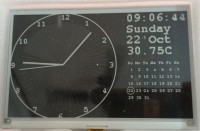7.5" E-Paper clock on ESP32

Wall clock on electronic paper. It has wide viewing angle and can be seen from distance. It can be seen even under broad daylight. Has maximum drawing current is 60 mili amp on a 3.7 volt Lion cell. It's best fit for solar powered wall clock particularly for park, market place or in large hall.
Prelude [Pros & cones]
I was simply fascinated by the bright colors of e-paper that are displayed even when the power supply is removed which is true for both black & white & color e-papers. The view angle of e-paper is 180 degree which is an extra advantage and they have no backlight and they reflect the same ambient that are incident on them. This results in extremely low power consumption for e-papers. I purchased a few e-papers even without knowing how to deploy them. One among my stock was a 7.5” black & white e-paper. One significant disadvantage of e-paper is that their refresh rate is not fast rather very slow – 3 seconds to 8 seconds. This is the main reason the e-papers have not yet entered in to the mobile screen area. They are mostly limited to e-readers and clock displays having only hour & minute displays.The project
This project is built on a 7.5” black & white e-paper [800X480 pixel area] a clock having a analog clock view with second hand display.Sure the second hand cannot move every second but in every 2 seconds and sometimes in 3 seconds the hand display works. The entire circuit takes about 60 milli ampere on a 3.7 volt LiPo / Lion cell and runs for two+ days non stop. In the event of power failure the one-cell back up will be more than enough!BOM
(Items | Price / Source)- ESP32 – MCU | INR:550 / USD$ 7 / robu.in, aliexpress.com, amazon.in
- HT7333A – 3.3V regulator | INR:30 / USD$1 / amazon.in
- 7.5” E-paper Black & White | INR:4799/USD$60/ amazon.in, robu.in, electronicscomp.com
- Wires, PCB, connector | Robu.in, amazon.in, aliexpress.com
- Cap 10MFD | INR:10 / amazon.in
Tricks & testing
Unlike in a normal Arduino programming what you put inside the loop {}, it keeps repeating, in e-paper programming you cannot repeat everything to have e-paper work. E-paper has display divided into two pages – firstPage and nextPage. You have to write in both the pages in reverse color so that when firstPage expires and nextPage starts the reverse colors will cancel each other and you will get your figures display properly. In the first page if you write white on black border in the next page you have to write the same figure [or text] with black on white border. If this is not followed you will have a flickering ghost image changing continuously! This is trick we used to have the display changing successfully every second inside the loop. For 3.3 volt we have used low power, low drop rate HT7333A voltage regulator. It’s quiescent current is 4 micro ampere. The input voltage is 12V to 3.47V such that when the input voltage reduces to 3.47V you still would be getting 3.3V for running the circuit.
Project Schematic
Project prototype




Discussie (2 opmerking(en))
Armin.G 1 jaar geleden
(I bolded the important parts)
Question:Precautions for e-ink screen refresh
Answer:
Question:What is the refresh rate/lifetime of the e-ink screen?
Answer:
Ideally, with normal use, it can be refreshed 1,000,000 times (1 million times).
End from Waveshare
------------------------------------------
On your YouTube Video there are lots of shades of the second pointer.
May be you should do frequently a full refresh (every 10 min or so).
And they say one should refresh max. every 180 seconds.
Uhhhh, lifetime 1 million refreshes ....
If refreshed once a second (or some seconds in your video)
1.000.000 / 60 / 60 / 24 = 11,57 Days
How about that ???
Greets
Armin
----------------------------------------------
I still know which side of the solder-iron to grab :-)
Armin.G 1 jaar geleden
But the best is the trick to use the E-Paper Display with the negative Image.
I experimented a lot with E-Paper Displays of the same type and wrote my own drivers in Atmel-Assembler code for several Atmel CPUs. Driver can display Images and Text in different sizes (and colors for some displays)
In none of the datasheets was a hint to use it with the second page in negative.
Fortunately in my projects flickering was no problem because I have update rates of several minutes.
Surely I will have a look at your program an will implement that to my drivers.
Thanks a lot for that !
Greets
Armin
----------------------------------------------
I still know which side of the solder-iron to grab :-)